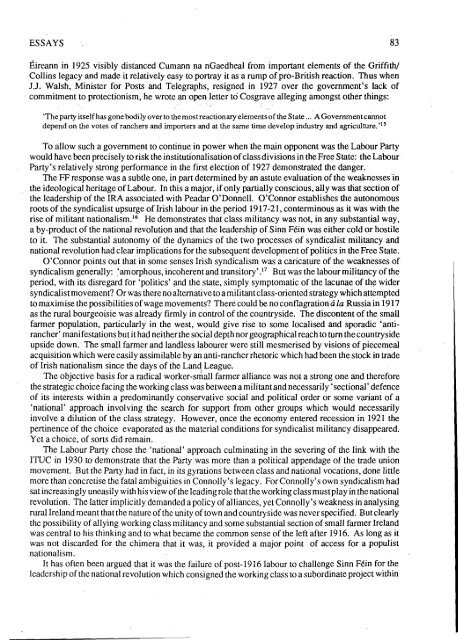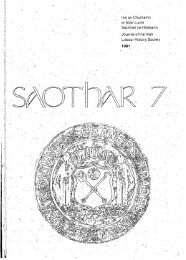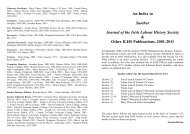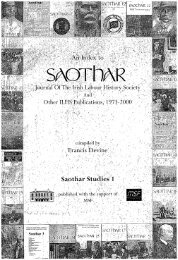82 SAOTHAR 13Tory Party? '8 This sense of the party's radical roots is one that is encouraged by the party itSelf. CharlesHaughey in 1974 reminded Dublin members that FF had come to power as a radical party;'At that time, Fianna Fail was looked upon by certain sectors as a troublesome, even dangerous arrival onthe scene. It represented a threat to the established order of things. That the established order includedslums, chronic unemployment, subsistence level farming and primitive health services, did not deter themfrom condemning Fianna Fail for wanting to upset it. '9Haughey was here reiterating a view of the party's history which had been established by Eamonde Valera. Mair quotes an interview given by de Valera in 1976 in which he claimed that in the earlyyears of the party he was worried that it was being perceived as too oriented towards the working class;'In those days I believe we could be called socialists, but not communists' .10 Indeed de Valera was notabove calling up the ghost of James ConnoUy at crucial junctures at this time. The left in Ireland maywell have underestimated the party's continuing ability, down to Haughey 's denunciation of the 1982-87 Coalition government's 'Thatcherism', their support by a reactionary clique of monetarist economistsand his own affiliation to Keynes, 'the last economist worth his salt'!1, to maintain a populist,radical appeal. .But it would be seriously to underestimate de Valera's own shrewd evaluation of the balance ofpolitical forces in the Free State to take him at his word on these issues. A better insight into his realcalculations is given in a letter to Joseph McGarrity, the leading Clan na Gael figure in the USA. It waswritten after the extraordinary Sinn Fein Ard Fheis in 1926 and the subsequent decision to create thenew party. Justifying this decision de Valera provided an interesting evaluation of the political situationin the Free State:'You will perhaps wonder why I did not wait any longer. It is vital that the Free State be shaken at the ,nextgeneral election, for if an opportunity be given it to consolidate itself further as an institution -if the presentFree State members are replaced by Farmers and Labourers and other class interests, the national interestas a whole will be submerged in the clashing of rival economic groups. '12The failure of abstentionism as a tactic after the Civil War has been ably documented by Pyne. 13 Butclearly de Valera was not simply concerned with Sinn Fein' s inability to hold onto its constituency, Theletter demonstrates a real fear that despite the limitations on, and truncated nature of, the independenceof the Free State, an early prediction of ConnoUy's about the progressive effects of self-governmentmight be materialising: .'An Irish Republic would be ... the natural repository of popular power; the weapon of popularemancipation, the only power which would show in the full light of day all those class antagonisms andlines of economic demarcation now obscured by the mists of patriotism. '14The end of 'Civil War politics' is something which has been often proclaimed since the 1960s, withthe Progressive Democrats being the latest in a long line of would-be realigners, more usually from theleft. Ironically it was de Valera, too often portrayed as a man of illusions and dreams, who clearheadedlyperceived that the Civil War fissure, though a deep and bitter one, would not inevitablyreproduce itself as the fundamental alignment in Irish politics.Although the division in the leadership of Sinn Hin over the Treaty had no crucial social oreconomic dimension to it, despite the clear reliance of the anti-Treatyites on the small farmers of thewest and the support for the Treaty of large farmers and the financial and mercantile bourgeoisie, theramshackle lumber room of Sinn Fein social policies would be visited increasingly by de Valera andhis lieutenants in the post Civil War years. This was, in part, a response to Cumann na nGaedheal'sevolution as party of government, an evolution which in itself helped to 'socialise' the Civil Wardivision. The Army Mutiny and the secession from the party of a group which constituted itself as Clann
ESSAYS 83Eireann in 1925 visibly distanced Cumann na nGaedheal from important elements of the Griffith/Collins legacy and made it relatively easy to portray it as a rump of pro-British reaction. Thus whenJ.J. Walsh, Minister for Posts and Telegraphs, resigned in 1927 over the government's lack of" commitment to protectionism, he wrote an"open letter to Cosgrave alleging amongst other things:'The party itselfhas gone bodily overto the most reactionary elements of the State .. , A Governmentcalmotdepend on the votes of ranchers and importers and at the same time develop industry and agriculture. '15To allow such a government to continue in power when the main opponent was the Labour Partywould have been precisely to risk the institutionalisation of class divisions in the Free State: the LabourParty's relatively strong performance in the first election of 1927 demonstrated the danger."The FP response was a subtle one, in part determined by an astute evaluation of the weaknesses "inthe ideological heritage of Labour. In this a major, if only partially conscious, ally was that section ofthe leadership of the IRA associated with Peadar O'Donnell. O'Connor establishes the autonomousroots of the syndicalist upsurge of Irish labour in the period 1917-21, conterminous as it was with therise of militant nationalism. 16 He demonstrates that class militancy was not, in any substantial way,a by-product of the national revolution and that the leadership of Sinn Fein was either cold or hostileto it. The substantial autonomy of the dynamics of the two processes of syndicalist militancy andnational revolution had clear implications for the subsequent development of politics in the Free State.O'Connor points out that in some senses Irish syndicalism was a caricature of the weaknesses ofsyndicalism generally: .'amorphous, incoherent and transitory' .17 But was the labour militancy of theperiod, with its disregard for 'politics' and the state, simply symptomatic of the lacunae of the widersyndicalist movement? Or was there no alternative to a militant class-oriented strategy which attemptedto maximise the possibilities of wage movements? There could be no conflagration a la Russia in 1917as the rural bourgeoisie was already fIrmly in control of the countryside. The discontent of the smallfarmer population, particularly in the west, would give rise to some localised and sporadic 'antirancher'manifestations but it had neither the social depth nor geographical reach to turn the countrysideupside down. The small farmer and landless labourer were still mesmerised by visions of piecemealacquisition which were easily assimilable by an anti-rancher rhetoric which had been the stock in tradeof Irish nationalism since the days of the Land League.The objective basis for a radical worker-small farmer alliance was not a strong one and thereforethe strategic choice facing the working class was between a militant and necessarily 'sectional' defenceof its interests within a predominantly conservative social and political order or some variant of a'national' approach involving the search for support from other groups which would necessarilyinvolve a dilution of the class strategy. However, once the economy entered recession in 1921 thepertinence of the choice evaporated as the material conditions for syndicalist militancy disappeared.Yet a choice, of sorts did remain.The Labour Party chose the 'national' approach culminating in the severing of the link with theITUC in 1930 to demonstrate that the Party. was more than a political appendage of the trade unionmovement. But the Party had in fact, in its gyrations between class and national vocations, done littlemore than concretise the fatal ambiguities in Connolly's legacy. ForConnolly's own syndicalism hadsat increasingly uneasily with his view of the leading role that the working class must play in the nationalrevolution. The latter implicitly demanded a policy of alliances, yet Connolly's weakness in analysingrural Ireland meant that the nature of the unity of town and countryside was never specified. B ut clearlythe possibility of allying working class militancy and some substantial section of small farmer Irelandwas central to his thinking and to what became the common sense of the left after 1916. As long as itwas not discarded for the chimera that it was, it provided a major point of access for a populistnationalism.It has often been argued that it was the failure of post-1916 labour to challenge Sinn Fein for theleadership of the national revolution which consigned the working class to a subordinate project within
- Page 1 and 2:
JOURNAL OF THE IRISH LABOUR HISTORY
- Page 3 and 4:
ContentsPageEditorial: Labour Histo
- Page 5 and 6:
EDITORIAL 3freedom to participate i
- Page 7 and 8:
CorrespondenceThe Irish Labour Part
- Page 9 and 10:
; ~ ; ,The Decline and Fall of Donn
- Page 11 and 12:
THE DECLINE AND FALL OF DONNYBROOK
- Page 13 and 14:
THE DECLINE AND FALL OF DONNYBROOK
- Page 15 and 16:
·' THE DECLINE AND FALL OF DONNYBR
- Page 17 and 18:
THE DECLINE AND FALL OF DONNYBROOK
- Page 19 and 20:
THE DECLINE AND FALL OF DONNYBROOK
- Page 21 and 22:
THE DECLINE AND FALL OF DONNYBROOK
- Page 23 and 24:
THE DECLINE AND FALL OF DONNYBROOK
- Page 25 and 26:
,'-,;-''''.A PASSAGE TO BRITAIN 23C
- Page 27 and 28:
A PASSAGE TO BRITAIN 25only in the
- Page 29 and 30:
A PASSAGE TO BRITAIN 27clothing._De
- Page 31 and 32:
A PASSAGE TO BRITAIN 29established
- Page 33 and 34: ;:-.",.- .. .", ...... '.:. '
- Page 35 and 36: LOUIE BENNETI 33feminist movement w
- Page 37 and 38: :... ~: ."
- Page 39 and 40: -.- '.LOUlE BENNETT 37While there i
- Page 41 and 42: LOUIE ~ENNEIT 39Xl's encyclical Qua
- Page 43 and 44: LOUIE BENNEIT 41Bennett's own relat
- Page 45 and 46: LODIE BENNETT 43109; IWWU resolutio
- Page 47 and 48: Essays in ReviewCosherers, Wanderer
- Page 49 and 50: ••• .".'. >. '~"ESSA YS IN RE
- Page 51 and 52: ESSAYS IN REVIEW 49ConnolIy:Myth an
- Page 53 and 54: ESSAYS IN ~EVIEW 51tion' in the Int
- Page 55 and 56: ESSAYS IN REVIEW53International:'I
- Page 57 and 58: REVIEWScontroversy is real history.
- Page 59 and 60: REVIEWSJoe Monks was among the earl
- Page 61 and 62: REVIEWSnolly-Column Song','Proudly
- Page 63 and 64: REVIEWSresulting from the arrival o
- Page 65 and 66: REVIEWS,63the book by means of an a
- Page 67 and 68: REVIEWSlogue, it is hardly surprisi
- Page 69 and 70: The Team For All Workers ...CULIAIB
- Page 71 and 72: ESSAYS 69mission and moral refonn.l
- Page 73 and 74: .. ...... ~.~ -~ .'- '.ESSAYS. 71fr
- Page 75 and 76: ESSAYS 73claimed authority but whic
- Page 77 and 78: ESSAYS 75provided the basis for soc
- Page 79 and 80: ESSAYS 779. For comparisons see E.T
- Page 81 and 82: ESSAYS 7952. Annals of Christ Churc
- Page 83: ESSAYS' 81Fianna Fail and the Worki
- Page 87 and 88: ESSAYS 85recognition of the impract
- Page 89 and 90: ESSAYS 871970, it created the condi
- Page 91 and 92: ESSAYS89The Irish Immigrants' Contr
- Page 93 and 94: ESSAYS" 91Although anti -Catholic p
- Page 95 and 96: ESSAYS 93McCowie played a key role
- Page 97 and 98: :. -,,'.' ',. .~.,:.ESSAYS 95Althou
- Page 99 and 100: ESSAYS 97young girl of their own ba
- Page 101 and 102: SourcesIrish Labour History Society
- Page 103 and 104: SOURCES 101INovember, 1971 to no. 1
- Page 105 and 106: SOURCES 103would claim credit for t
- Page 107 and 108: SOURCES105Sources for Irish Labour
- Page 109 and 110: SOURCES 107NorthWest Archives and L
- Page 111 and 112: SOURCES 109In 1966 the Finnish gove
- Page 113 and 114: TURNINGANEWLEAFThe CPSSUis the larg
- Page 115 and 116: REMINISCENCE 113us due to my politi
- Page 117 and 118: REMINISCENCE 115when Jim was presen
- Page 119 and 120: REMINISCENCE 117of Dail Eireann. 17
- Page 121 and 122: REMINISCENCE 119NotesThe above arti
- Page 123 and 124: DOCUMENT STUDY 121James Connolly in
- Page 125 and 126: DOCUMENT STUDY123SOCIAL DEMOCRATIC
- Page 127 and 128: DOCUMENT STUDY 125proletariat of th
- Page 129 and 130: DOCUMENT STUDY 127the support of Je
- Page 131 and 132: DOCUMENT STUDY 12926. The Workers'
- Page 133 and 134: 131BibliographyA Bibliography of Ir
- Page 135 and 136:
BIBLIOGRAPHY 133Compton, P.A. Demog
- Page 137 and 138:
BIBLIOGRAPHY 135Levine, I. and Madd
- Page 139 and 140:
BIBLIOGRAPHY 137Turner, M. 'Towards
- Page 141 and 142:
BIBLIOGRAPHY 1394. Land and Agricul
- Page 143 and 144:
BIBLIOGRAPHY 141Clogher Record12 (2
- Page 145 and 146:
BIBLIOGRAPHY 143Political Research
- Page 147 and 148:
BIBLIOGRAPHY 145Pres, 1987.O'Brien,
- Page 149 and 150:
147Notes on Contributorsf onathanBe
- Page 151 and 152:
1901: Ireland's first general union
- Page 153 and 154:
ELECTRICAL TRADES UNION .Establishe





